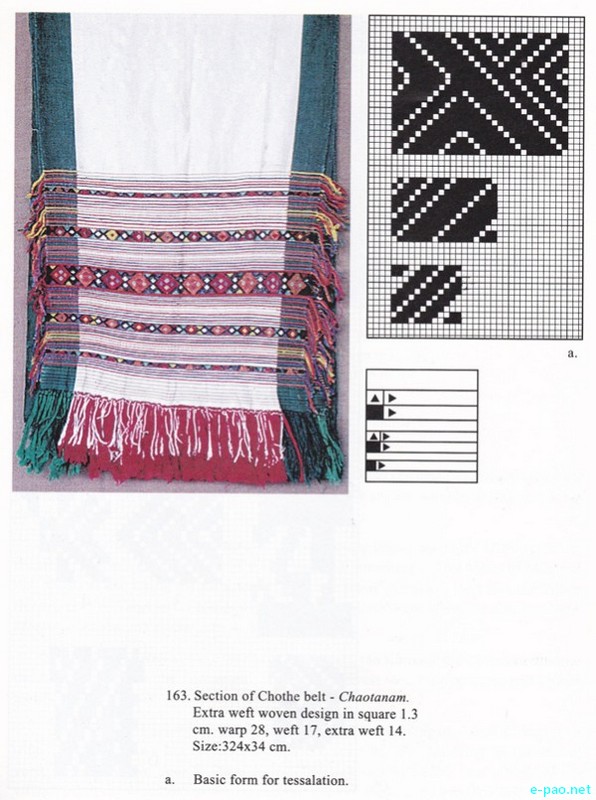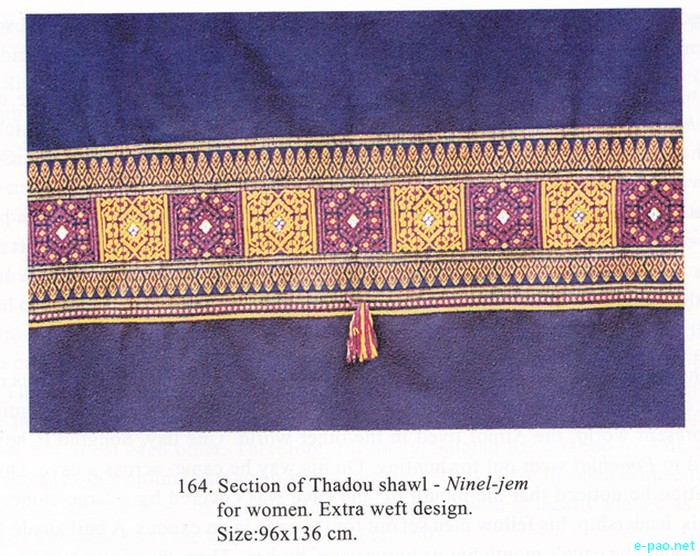Tribal hand woven fabrics of Manipur
- Part 19 -
By: Mutua Bahadur *


They ate the python and gave the intestine as the share of the two brothers. The two brothers took the skin and dried it in the sun. While the intestine was prepared for cooking, to their astonishment, they found a Turongdar (gong) inside the intestine. When the gong was banged, it produced seven sounds. Because of the gong they gradually prospered and became rich. Then, Neileisak married a beautiful girl of the village named Thirchong. Thirchong wove a cloth with snake pattern, imitating the hanging skin of the python. Thus, snake design was produced.
The Tarao also tell a story about the initiation of python design in their cloth known to them as Leijing (Fig. 159). In the remote past, there lived a very beautiful girl in the village of Tarao. Every day, she went to the field to scare away the birds. For this purpose, she used a bell made of bamboo called Barphak, which was rung by means of a long rope fastened to it. One day, the rope fell and tore in two pieces. Suddenly, the snake-god Pakhangba emerged and tied the rope for the beautiful girl.
This incident made them known to each other. The snake-god fell in love with the Tarao girl and they passed days together in a hut on the field. Her father was very angry with their intimate affair. But she loved snake-god deeply. As token of her love and affection, she lovingly wove the cloth with the skin mark of her lover as the design of her cloth.
Awamphi, the national cloth of the Chothe, also bears this python-scale design. Awamphi or Leiyengphi (Fig. 158), as known to the Purum, is the cloth which their forefathers brought with them when they emerged from a cave. Their story runs thus : There was a cave in the west. Any man coming out of the cave was eaten by a tiger. But an old man of Makhan lineage came out wearing a cloth, the Leiyengphi.
The cloth had the pattern of skin spots of a tiger. The tiger seeing the cloth took the man as its kin. It did not eat him. They talked and became friends. They also made promise not to kill each other. If any of them ate each other’s flesh, their teeth would fall. Other persons followed him but the tiger did not eat any of them.
The Aimol also have a belief that their cloth known as Ponchial Rulpuiyek is related to their cave legend which is somewhat similar to the Purum folk tale. Before coming out in the present world, the Aimol lived in the other world. One day, Songthu (Chongthu) wrapped in Ponchial went out for hunting. On his way he came across a cave. On close observation he noticed that the mouth of the cave was covered by a large stone.
Then, under his leadership, his fellow men set out for the cave in an exodus. A bull made a great effort to open the cave’s mouth but its horns were broken. Then, the spotty mithun pushed the stone and the cave was opened. They entered the cave but encountered a tiger. All of them retreated for fear of the tiger, and they stopped their mission. Songthu entered the cave wearing a Ponchial. The stripe on the back of the tiger and design pattern of his cloth were to some degree looked similar. This made the tiger think him as a member of its family. They became friends and vowed not to eat each other. They also cursed each other that one who failed to keep the vow would fall teeth.
The Aimol at Unapal village of Pallel tell the story a little differently from the above story current at Aimol Khullel. The Aimol came out from ‘under earth habitation’ in a cave at Khurpi and they found a tiger blocking them. Two clever persons, Pu Korthangpu and Pu Korthangpi, wove a cloth named Laijiang or Ponchial Rulpuiyeak which had the same pattern and colour as the tiger.
Wearing the cloths helped Pu Korthangpu in deceiving the tiger. The tiger considered him to be one of its kin and did not eat. The tiger was then killed with a spear while it was unprepared. Thus, all were able to come out. But, according to Ch. Alingir, Khullakpa of Unapal (in 1997), the man who successfully ventured against the tiger was Chaithu.
A version of this myth is prevalent among the Koireng too. Their forefathers were believed to have come out of a cave whose exact location could not be recounted wrapped in a shawl called Ponthal (Fig. 162) that had the appearance of tiger-like patterns, was able to befriend the tiger and thereafter his folks were allowed to come out of the cave. Since then, the members of Song clan have the taboo to eat the meat of tiger and other animals of the genus; neither have they been attacked by tigers.
Oral tradition of the Kharam also includes a somewhat similar story. The Kharam believe themselves to have originated from a cave. The whereabouts of the cave was lost in the passage of time. When they came out from the cave in succession, a ferocious tiger ate them one by one. No one could come out any more. They did not even know which animal it was. One day, an old woman peeped out and saw a big man-eater at the mouth of the cave. She then wove a cloth having the colour pattern of the tiger. On the white background, a tiger motif with yellow, red and black were intertwined.
Wearing the cloth an old man of Saichal, a clan of the Kharam, led a group of persons to come out from the cave. The tiger seeing the tiger motif on the cloth took them as its kin. The tiger did not attack them. The Saichal old man and the tiger introduced themselves. Then they made promise not to eat each other. Therefore, till today, Saichal has a taboo to kill, eat tiger flesh and any other animal having an affinity to tiger. Thus, all of the men came out and the tiger considered them as its friends. The motif on the cloth is locally known as Humpui and the cloth was given the name Thompui (Fig. 160).
Among the Chothe, the Purum (Chothe), the Purum (Kom) and the Aimol, there is a folk tale about a hero called Rangam who was strong, wise and possessed magical skills. In a cloth of these tribes, designs representing his arrow and lunch pack are formed. The Kom of Khoirentak village also have a tale about the mighty Ralngam but the story is not conventionalised in their cloths. The Aimol believe that creation of patterns representing the arrow of Ralngam will depict the ability of the great hero to the enemies.
The Kom also believe that, in the olden days, there was a woman called Chongmu. She wove in a loin loom near a stream. With the rippling sound of the flowing water, there came out living beings such as python, crab, etc. Whatever she saw emerging out of the stream was crafted in the cloth touted in her loom. Till today, the story of weaving by Chongmu near the stream is handed down in their folk song. And the cloth made by Chongmu is still woven by the present-day Kom weavers under the name of Nuhmeipun (Fig. 161).
The same story exists in the Koireng version. One day Chongmu and her husband went for hunting in the deep jungle. But her husband was hunted by a wild bison. The heartbroken Chongmu, shedding tears, sat down near a stream and arranged her loom. All the creatures she saw coming out of the stream were portrayed as designs of her cloth. The cloth was Ponthal. At present, Ponthal is the honorary wear of the Koireng nobility. In a more or less similar version, the Purum (Kom) tell a story about one Chaonu who set up her loom near a stream and created designs in the image of the creatures she saw. The cloth was named Aipui Ruko (Fig. 115). The Purum also believe that all the customary cloths are the handiwork of Chaonu.
A somewhat similar story as mentioned above is heard from the Chothe. A couple was going out to a far place. On the way Loyaampa, the husband was kept under a large stone by a man. Ngamtha, the helpless poor wife wept. Hearing her cry, a crab came out and brought out one after another, the physical parts of her husband — hand, nail, eye, teeth, etc. There, she wove and in her cloth, she made distinct designs of each and every part of her husband brought out by the crab. For her weaving, the birds supplied thread. The cloth was Chaotanam (Fig. 163), the favourite cloth of the Chothe and a cloth inseparable from the Chothe culture.
The Sukte believe that the designs they are using in their cloths are learnt from the fairies — Sikha Nungnga. In olden times, the Sukte bachelors roamed and visited the places of the fairies. The designs they had seen at the fairies’ places were taught to their women and the women brought out the designs in their cloths.
References
1. T.C. Hodson. The Naga Tribes of Manipur, 1911, reprint India 1989.
2. McCullock, Statistical Account of Manipur, 1859.
3. O. Bhogeswor Singh, Loiyumba Sinyen, 1991, Imphal.
4. Mutua Bahadur, Manipuri Artki Wari Singbul, Vol. I, II, 1973, 1974, Imphal.
5 Mutua Bahadur, Tribal Art of Manipur, 1989, reprint 1996, Imphal.
6. Mutua Bahadur, Traditional Textiles of Manipur, 1997, Imphal.
7. Mutua Bahadur and P. Gunindra Singh, Cultural Revolution in Manipur, ‘Manipur Past & Present’ Vol. 2, 1991, New Delhi.
See a gallery photo of Tribal hand woven fabrics of Manipur here.
Concluded....
|
* Mutua Bahadur contributes to e-pao.net regularly. This article was webcasted on February 01, 2014.
* Comments posted by users in this discussion thread and other parts of this site are opinions of the individuals posting them (whose user ID is displayed alongside) and not the views of e-pao.net. We strongly recommend that users exercise responsibility, sensitivity and caution over language while writing your opinions which will be seen and read by other users. Please read a complete Guideline on using comments on this website.









